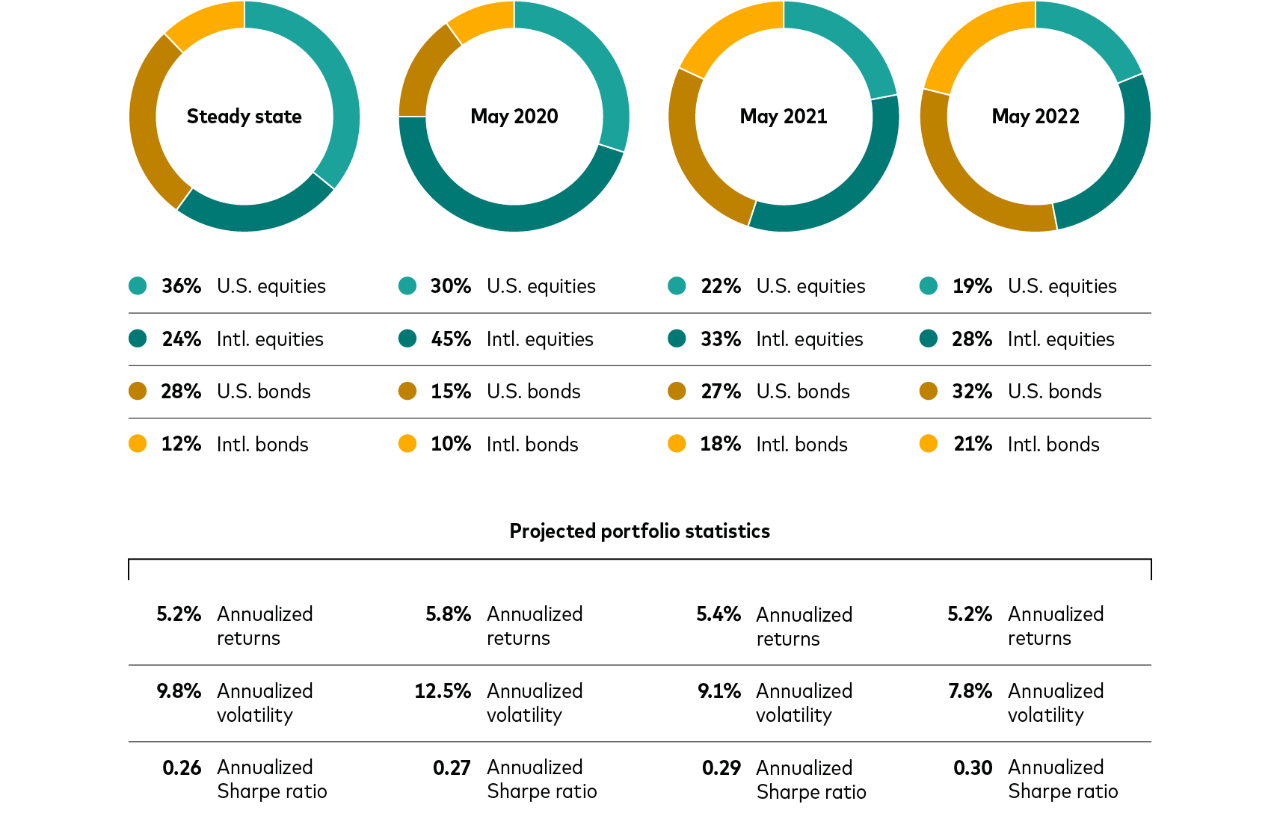Expert insight
Fed cuts: How far matters more than how fast
November 04, 2024
The Federal Reserve appears poised to cut short-term interest rates on November 7. Although markets and investors tend to focus on the Fed’s next move, a far more consequential question for investment portfolios is where the policy rate settles over the long run. Whether the economy lands soft or hard as the Fed unwinds its inflation-fighting hiking cycle, we expect interest rates to settle well above their pre-pandemic levels. And that makes a strong case for bonds.
Soft and hard landings and the policy rate path
The central theme of our economic and market outlook for 2024 was that interest rates above their pre-pandemic levels were here to stay. The implication for the Fed was that the neutral rate—the projected level of interest rates that theoretically would keep an economy from running too hot or too cold—was higher than in the previous decade. We considered factors such as rising structural fiscal deficits and an aging population in concluding that the nominal neutral rate was around 3.5%.
The Fed has acknowledged a rising neutral rate, increasing its estimate three times this year to its current estimate of 2.9%. I’d expect the Fed to increase its estimate even further throughout 2025.
As the Fed reduces its federal funds rate target from the current range of 4.75%–5% over the coming months, it will ease its grip on an economy that’s no longer under the imminent threat of runaway inflation.
Finding the right balance in the pace of rate cuts is every central banker’s toughest task. Going too slow increases the risk of a hard landing; going too fast increases the risk of reigniting inflation. Naturally, the Fed has been laser-focused on forging a middle path, or a soft landing.
My colleagues Ziqi Tan, Ian Kresnak, and I have leveraged the Vanguard Capital Markets Model® (VCMM) to project potential interest rate scenarios for 2025 with the goal of assessing what matters most for portfolios’ longer-term health. We analyzed what alternative Fed rate paths would mean for U.S. stock and bond returns under both soft landing and hard landing scenarios. In both cases, we also factored in our view of a higher nominal neutral rate of 3.5% and how that compares to a scenario where we return to a low-rate environment, closer to pre-COVID levels, with a neutral rate in the range of 2%–2.5%.

Our scenario-based 10-year forecasts for short-term interest rates
Notes: The figure shows the range of expected U.S. policy rates from September 2025 through September 2034. Here, a soft landing implies that the economy is slowing but continues to expand over the next two years, and a hard landing implies that the economy tips into recession over the next two years. The forecasts are based on resampling the Vanguard Capital Markets Model® simulations by U.S. 3-month Treasury yields and growth. The three scenarios are a subset of the 10,000 VCMM simulations as calculated on September 30, 2024. The bands shown for the soft and hard landing scenarios represent a deviation of 75 basis points from our estimate of the median U.S. 3-month Treasury yield. The forecast figures that are shown for the soft and hard landing scenarios one year from now and at the end of 2034 are our median forecasts for the U.S. 3-month Treasury yield.
IMPORTANT: The projections and other information generated by the VCMM regarding the likelihood of various investment outcomes are hypothetical in nature, do not reflect actual investment results, and are not guarantees of future results. Distribution of return outcomes from VCMM are derived from 10,000 simulations for each modeled asset class. Simulations are as of September 30, 2024. Results from the model may vary with each use and over time. For more information, please see the Notes section at the end of this commentary.
Source: Vanguard.
What a higher neutral rate could mean for long-term asset returns
As the Fed embarks on a rate-cutting cycle, it will become apparent to investors and markets that how low the Fed goes is more important than how much it cuts meeting-to-meeting.
Our projections for U.S. stock and bond returns through 2034 don’t differ a lot on whether we see a soft or a hard landing in the near term. Under both scenarios, we forecast the median average annualized return for U.S. stocks to run a little under 4%, while U.S. long-term Treasuries and credit are expected to come in materially over 4% and with less volatility.1 The case for stocks improves and the case for bonds weakens under a return to a low-rate environment.
A diversified, balanced portfolio of stocks and bonds serves long-term investors well in all potential future interest rate scenarios. However, some investors may have the requisite risk tolerance and be comfortable, guided by appropriate financial advice, with the idea of dynamically altering their portfolio’s long-term positioning based on market conditions. Those conditions currently favor bonds.
What might a tilt to bonds look like?
We considered an optimal portfolio for a hypothetical investor comfortable with targeting a 70% stock and 30% bond allocation using the return expectations we’ve outlined. As the figure that follows shows, the optimal portfolio using a neutral rate of 3.5% would be about 60% stocks and 40% bonds for that investor if we were to see a soft landing, and roughly 50% stocks and 50% bonds in the event of a hard landing.
While the differences in those allocations are not negligible, they are far closer than for allocations based on a 2.2% neutral rate—a scenario we consider very unlikely. In that pre-pandemic rate scenario, our optimal portfolio estimate would be 74% stocks and 26% bonds.
Our optimal asset allocation estimates for a 70% stock/30% bond investor under three scenarios
Notes: Portfolio allocations were determined by the Vanguard Asset Allocation Model. The assets under consideration were U.S. and non-U.S. equities, non-U.S. fixed income, short-term U.S. Treasuries, long-term U.S. Treasuries, and U.S. credit. Vanguard Capital Markets Model® 10-year initial condition projections are as of September 30, 2024. For the soft-landing scenario, the allocation to U.S. short-term Treasuries is 2%. Percentages for each allocation may not add up to 100% due to rounding.
IMPORTANT: The projections and other information generated by the VCMM regarding the likelihood of various investment outcomes are hypothetical in nature, do not reflect actual investment results, and are not guarantees of future results. Distribution of return outcomes from VCMM are derived from 10,000 simulations for each modeled asset class. Simulations are as of September 30, 2024. Results from the model may vary with each use and over time. For more information, please see the Notes section at the end of this commentary.
Source: Vanguard.
A word of caution for equity bulls
Investors bullish on stocks with today’s high valuations have to assume one of three things (or all of them): that the U.S. economy will likely avoid recession in the near term, that the benefit of artificial intelligence to future corporate profits will exceed already lofty expectations, or that the neutral rate will return to pre-COVID levels. We don’t expect a return to a low neutral rate. And whether we see a soft landing or a hard landing, our long-term U.S. equity return expectations are subdued.
1 In our soft-landing scenario, the median annualized 10-year returns are 3.90% for U.S. stocks, 4.33% for U.S. long-term Treasuries, and 4.54% for U.S. credit. In our hard-landing scenario, the median annualized 10-year returns are 3.70% for U.S. stocks, 4.48% for U.S. long-term Treasuries, and 4.39% for U.S. credit.
Contributors:

Ziqi Tan, CFA
Vanguard Investment Strategist

Ian Kresnak, CFA
Vanguard Investment Strategist
Notes: All investing is subject to risk, including the possible loss of the money you invest.
Be aware that fluctuations in the financial markets and other factors may cause declines in the value of your account. There is no guarantee that any particular asset allocation or mix of funds will meet your investment objectives or provide you with a given level of income.
Investments in bonds are subject to interest rate, credit, and inflation risk.
Investments in stocks or bonds issued by non-U.S. companies are subject to risks including country/regional risk and currency risk. These risks are especially high in emerging markets.
U.S. government backing of Treasury or agency securities applies only to the underlying securities and does not prevent share-price fluctuations. Unlike stocks and bonds, U.S. Treasury bills are guaranteed as to the timely payment of principal and interest.
IMPORTANT: The projections and other information generated by the Vanguard Capital Markets Model regarding the likelihood of various investment outcomes are hypothetical in nature, do not reflect actual investment results, and are not guarantees of future results. VCMM results will vary with each use and over time.
The VCMM projections are based on a statistical analysis of historical data. Future returns may behave differently from the historical patterns captured in the VCMM. More important, the VCMM may be underestimating extreme negative scenarios unobserved in the historical period on which the model estimation is based.
The Vanguard Capital Markets Model® is a proprietary financial simulation tool developed and maintained by Vanguard's primary investment research and advice teams. The model forecasts distributions of future returns for a wide array of broad asset classes. Those asset classes include U.S. and international equity markets, several maturities of the U.S. Treasury and corporate fixed income markets, international fixed income markets, U.S. money markets, commodities, and certain alternative investment strategies. The theoretical and empirical foundation for the Vanguard Capital Markets Model is that the returns of various asset classes reflect the compensation investors require for bearing different types of systematic risk (beta). At the core of the model are estimates of the dynamic statistical relationship between risk factors and asset returns, obtained from statistical analysis based on available monthly financial and economic data from as early as 1960. Using a system of estimated equations, the model then applies a Monte Carlo simulation method to project the estimated interrelationships among risk factors and asset classes as well as uncertainty and randomness over time. The model generates a large set of simulated outcomes for each asset class over several time horizons. Forecasts are obtained by computing measures of central tendency in these simulations. Results produced by the tool will vary with each use and over time.
CFA® is a registered trademark owned by CFA Institute.
